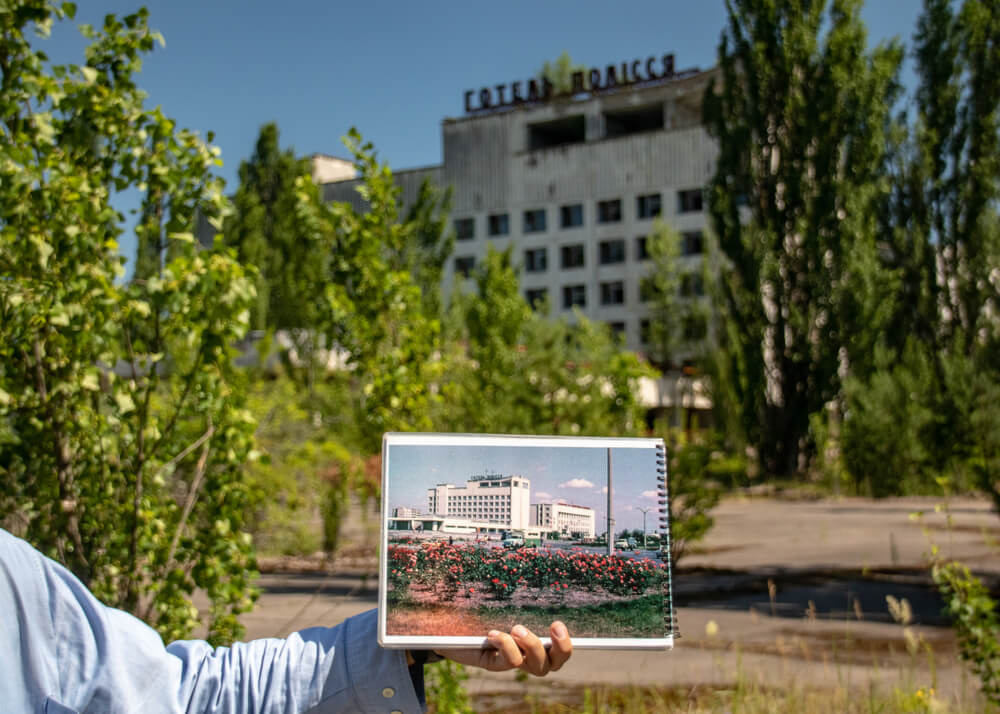Time machine: why do stalkers renovate houses in Pripyat
Classic Soviet room: desk, carpet on the wall, posters of Tsoi and Vysotsky, rotary telephone and table lamp. Everything is like in the mid-1980s, a ready-made interior for a work by the Strugatsky brothers. But outside the window of this room is Pripyat. A city that has been dead for more than 30 years, the appearance of which was actually foreseen by the aforementioned Strugatskys in “Roadside Picnic” and Tarkovsky in “Stalker,” writes Air force.

Photo: Shutterstock
People who have been to this room admit that the sharp contrast between it and the ruins of the rest of the abandoned Pripyat premises makes it uncomfortable.
Thus, a group of modern Ukrainian “illegal tourists” in the exclusion zone is trying to recreate the atmosphere of 1986 there and give the long-abandoned apartments the look they had before the accident at the Chernobyl nuclear power plant.
And the State Agency for the Management of the Exclusion Zone told BBC News Ukraine of official plans to reproduce the atmosphere of the 1980s at several sites.
Back to 1986
Stanislav “Polessky” is a video blogger and stalker who has been visiting the exclusion zone for more than ten years (legally and illegally).
“When I first went to Pripyat in 2007, I really wanted to see frozen time, to see the Soviet Union. Expectations were not met. In the official 16-story building I saw only empty, looted apartments with broken furniture,” he recalls.
And he adds: instead of the conventional “museum 1986”, I came across only the “museum of looters”.
“So we decided to turn back the clock in at least a few places. After all, Pripyat now is ruins into which time and looters turned the city,” notes Stanislav.
This is how the informal stalker project “Time Machine” was born, in which they try to reconstruct various rooms of an abandoned city.
The stalkers have already made repairs in two rooms of the Teremok kindergarten (a bedroom and a playroom), in the kitchen of one of the Pripyat apartments, as well as in the living room.
“We consider the Chernobyl zone a unique and historically important place that we want to preserve in any way. And the goal of our project is to return some places to their former appearance, before they were looted by looters. A view that will allow you to plunge into the atmosphere of frozen time,” explains Stanislav in one of his videos.
Water from Pripyat and work at night
“Polessky” clarifies that the most difficult thing is to find the right location for repairs, that is, a room with intact windows, floors and walls that does not leak too much.
Another parameter is radiation.
“We need to measure the room with a dosimeter before reconstruction so that it is not too dirty,” says the stalker.
In one of the rooms, for example, they found a “beta spot” with radiation of 400 microroentgens near the window (a radiation level of up to 50 microroentgens per hour is considered safe for humans. - Ed.)
“This is because, probably, the windows were slightly open (in April 1986. - Ed.). People didn’t listen to anyone, they didn’t close the windows. And this is the effect,” Stanislav suggests in his blog.
“But if you don’t eat or smoke there, then everything will be fine,” he adds.
Materials for repairs had to be carried across the entire exclusion zone, and water for diluting the paint was taken from the Pripyat River.
“Radiationally, it is clean, if you don’t stir up the silt,” the stalker notes.
The first repairs in the kindergarten had to be done at night so that Pripyat security would not notice from the street.
“Because we were there illegally and the police could catch us at any moment. When we were doing the first renovations in the kindergarten, the police “received” us, drew up a protocol, inspected our things and took us out of the exclusion zone,” recalls “Polessky.”
Actually, the legalization of their repairs is what the stalkers are trying to negotiate with the administration of the exclusion zone.
“We are working in this direction, we want to reach the official level and resolve the issue in order to make a real museum in Pripyat,” says Stanislav.
On the subject: 'Everybody twists my life': the first interview of Lyudmila Ignatenko after the series 'Chernobyl'
According to him, he has already spoken with representatives of the State Agency for Management of the Exclusion Zone, but whether everything will be resolved officially is an open question.
One of the main obstacles is the ban on entering all buildings in Pripyat due to their disrepair.
Even five years ago, even official tourist excursions were allowed to visit some of the houses, but later this was prohibited under the administrative responsibility of guides.
Stalker “Polessky”, who himself was once an official guide, believes that not all Pripyat houses are dangerous.
If they are checked and those that are best preserved are reconstructed (for example, the same kindergarten No. 8 “Teremok”), then they can be completely safe for tourists, he claims.
Moreover, the restored rooms in Pripyat can become another object for foreign tourists - along with a Ferris wheel and an amusement park, the Polesie hotel and a river port.
“Some guides already unofficially take tourists to our locations,” says Stanislav.
Contrast
“Every minute it becomes somehow uneasy. We are in Pripyat, and everything here is so neat and beautiful,” Stanislav’s wife Victoria describes her emotions after visiting a renovated room in Pripyat.
Most of the things there are original, from Pripyat.
Wallpaper and a huge map, for example, were glued by the former owners before the accident, now the stalkers had to simply glue them.
The table and bed were found in neighboring apartments.
The only problem was with the refrigerator for the kitchen - they were taken out of Pripyat by the liquidators in 1986.
The lamp, telephone, watch and posters of Tsoi and Vysotsky have already been searched for at flea markets in front of the entrance to the exclusion zone or sent by subscribers of the Polessky channel.
“When you walk through abandoned apartments and suddenly find yourself in a renovated room, it becomes very strange. Honestly, unusual emotions - here you are in a normal room, albeit a Soviet one, but outside the window there is a dead city and even beyond the threshold everything is in ruins,” says Stanislav “Polessky”.
Now his plans are to reconstruct the entire apartment, not just one room.
“We want to make an apartment-museum of 1986. For now it’s difficult because we do everything illegally. If we were allowed to do everything officially, I think it would be a very cool project that would appeal to tourists, stalkers, and the administration of the exclusion zone,” the stalker reflects.
On the subject: Trip to Chernobyl: than the exclusion zone attracts thousands of foreign tourists. PHOTO
Official plans
The State Agency for the Management of the Exclusion Zone (GAZO) told BBC News Ukraine that they are considering the possibility of a technical survey of several buildings in Pripyat.
If the expert opinions are positive, then these objects will be taken over by the agency and they will try to recreate the atmosphere of the late 1980s there, “so that visitors to the exclusion zone can see and feel the life of that time.”
Possible objects include a kindergarten, a school, a swimming pool, a bus station and several apartments.
In addition, in Pripyat, preparations are already underway to create a museum of equipment that was used during the liquidation of the Chernobyl accident.
“All exhibits will undergo radiation dosimetric examination, and, if necessary, decontamination,” they say at GAZO.
Also in the plans is a museum of folk culture and life in the vicinity of Chernobyl.
Tourism and public organizations can be involved in these initiatives, and they are also looking for additional funding.
The project itself was called “Ukrainian Magnets: Chernobyl” - “magnets” here means an attraction for foreign and Ukrainian tourists.
Read also on ForumDaily:
Three underground lakes with water were found on Mars: can this be a sign of life
Different than we imagined: what do Americans think about Ukraine
Soundtrack at the Grammy: how a Ukrainian from the USA created the music for Chernobyl
Not only Beirut: 11 terrible human-induced disasters
Subscribe to ForumDaily on Google NewsDo you want more important and interesting news about life in the USA and immigration to America? — support us donate! Also subscribe to our page Facebook. Select the “Priority in display” option and read us first. Also, don't forget to subscribe to our РєР ° РЅР ° Р »РІ Telegram and Instagram- there is a lot of interesting things there. And join thousands of readers ForumDaily New York — there you will find a lot of interesting and positive information about life in the metropolis.











